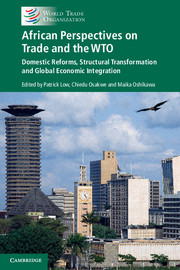 African Perspectives on Trade and the WTO
African Perspectives on Trade and the WTO Book contents
- African Perspectives on Trade and the WTO
- African Perspectives on Trade and the WTO
- Copyright page
- Contents
- Figures
- Plates
- Contributors
- Message
- Joint Foreword
- Book part
- Glossary
- Disclaimer
- 1 Introduction and Overview
- Part I The Future of the Multilateral Trading System: Perspectives from African Policy-Makers and Partners
- Part II Africa’s Participation in the Rules-Based Multilateral Trading System
- 10 Rising Africa in World Trade? A Story of Traditional Commodities and New Products
- 11 Trade Policy Trends in Africa: Empirical Evidence from Twenty Years of WTO Trade Policy Reviews
- 12 Preferential Trade Agreements in Africa: Lessons from the Tripartite Free Trade Agreements and an African Continent-Wide FTA
- 13 African Trade Integration and International Production Networks
- 14 Implementing Trade Facilitation Reform in Africa
- Part III Selected Development Experiences and Perspectives
- Book part
- Index
- Plate Section (PDF Only)
- Book part
- References
12 - Preferential Trade Agreements in Africa: Lessons from the Tripartite Free Trade Agreements and an African Continent-Wide FTA
from Part II - Africa’s Participation in the Rules-Based Multilateral Trading System
Published online by Cambridge University Press: 27 October 2016
- African Perspectives on Trade and the WTO
- African Perspectives on Trade and the WTO
- Copyright page
- Contents
- Figures
- Plates
- Contributors
- Message
- Joint Foreword
- Book part
- Glossary
- Disclaimer
- 1 Introduction and Overview
- Part I The Future of the Multilateral Trading System: Perspectives from African Policy-Makers and Partners
- Part II Africa’s Participation in the Rules-Based Multilateral Trading System
- 10 Rising Africa in World Trade? A Story of Traditional Commodities and New Products
- 11 Trade Policy Trends in Africa: Empirical Evidence from Twenty Years of WTO Trade Policy Reviews
- 12 Preferential Trade Agreements in Africa: Lessons from the Tripartite Free Trade Agreements and an African Continent-Wide FTA
- 13 African Trade Integration and International Production Networks
- 14 Implementing Trade Facilitation Reform in Africa
- Part III Selected Development Experiences and Perspectives
- Book part
- Index
- Plate Section (PDF Only)
- Book part
- References
Summary
Economic transformation is an important pre-requisite for African countries to maximize the benefits of globalization. The development outcomes of the transformation process are conditioned on the one hand by the level of inclusiveness and on the other by the sustainability of the development pathways, among other factors. Building on experiences since the new millennium, in which Africa has witnessed rapid and sustained high levels of economic growth, and informed by the policy discourse that accompanied the formulation of the Common African Position on Sustainable Development Goals, African countries have charted a transformation path in which they aspire to play to their comparative advantages.
The transformation path that is also articulated in Africa’s Agenda 2063 is one that rests on structural change in which industrialization plays a greater role. The comparative advantages in support of the envisaged structural transformation include an abundance of natural resources whose value can be enhanced before consumption or trade; a potentially large integrated continental market; a young, healthy and educated population; rapid urbanization complemented with falling costs of transport and communication due to increased public investments in infrastructure; and rapidly falling energy costs, especially in renewables.
Yet, in spite of the well-articulated development pathway and the existing comparative advantages, without trade, Africa is unlikely to enjoy the full benefits of its transformation process. Fortunately, the recognition of trade as a key development tool in Africa is not in doubt. Past and present development strategies have endeavoured to unlock latent economic potential through trade, albeit with mixed results. The regional integration process as a development imperative in Africa has consistently placed market integration at the heart of efforts to realise an integrated and prosperous African market. Indeed, contrary to widely held perceptions, Africa is on track as per the Abuja Treaty. There are also efforts to address speed bumps that could slow the process as evidenced by the Tripartite Free Trade Area (TFTA) between COMESA (the Common Market for Eastern and Southern Africa), EAC (the East African Community) and SADC (the Southern African Development Community), and the launch of the Continental Free Trade Area (CFTA) negotiations.
This chapter presents and analyses the results and empirical evidence based on the trade policy landscape in which Africa has been involved and also the prospects of the current initiatives, such as the Tripartite Free Trade Area and the CFTA. Based on the evidence, the chapter argues that it is possible for Africa to ride on trade, not only to industrialize by exploiting the continental market, but also bring about structural transformation in which services play a critical role. But for this to happen, Africa must harness regional integration to the fullest while at the same time making maximum use of the opportunities the multilateral trading system offers. In a global political economic context where there is a multiplicity of trade agreements, this chapter argues that the sequencing of actions and the scope of the agreements are important determinants of the final development outcome.
- Type
- Chapter
- Information
- African Perspectives on Trade and the WTODomestic Reforms, Structural Transformation and Global Economic Integration, pp. 230 - 268Publisher: Cambridge University PressPrint publication year: 2016
References
- 1
- Cited by


